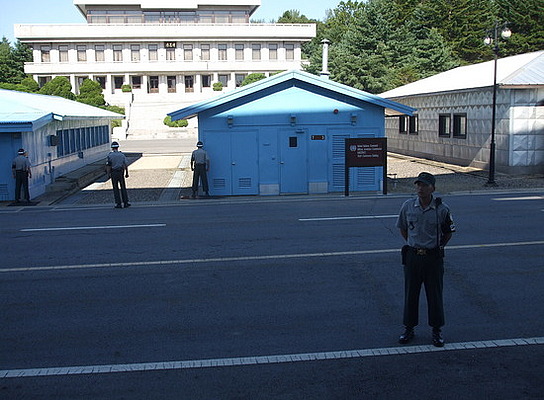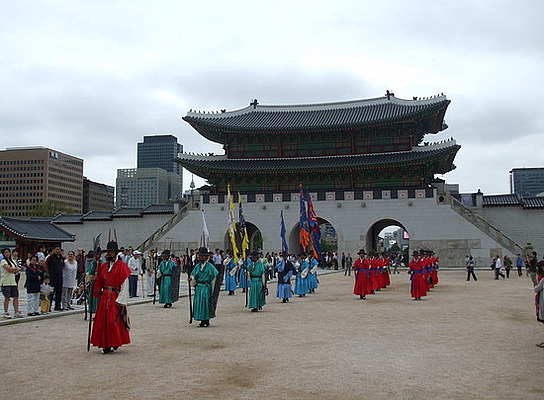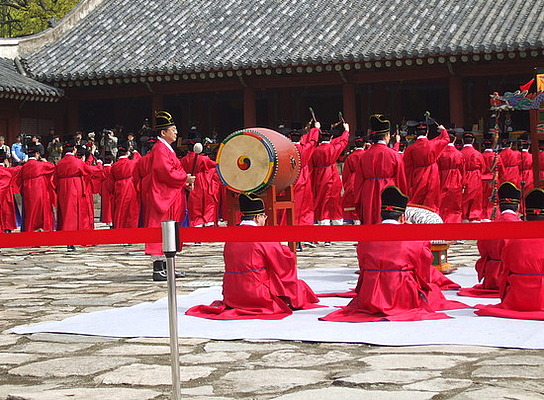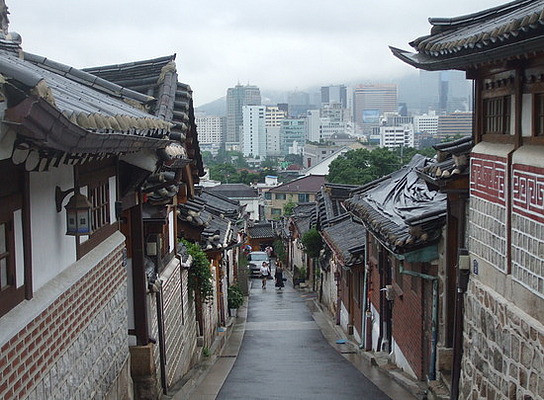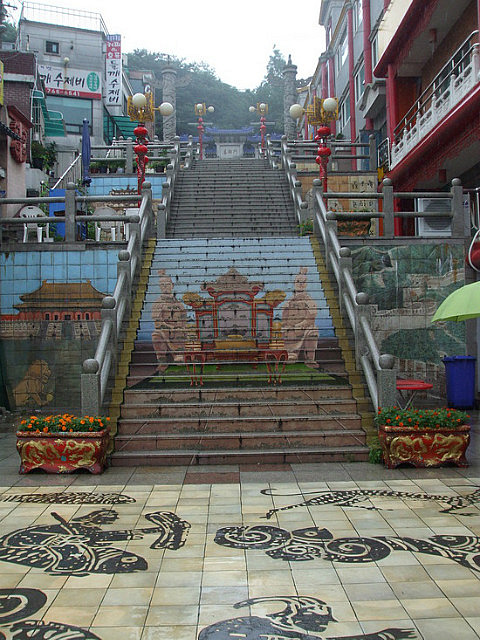Profile
Blog
Photos
Videos
Adventures of a Global Wanderer
I've seen a few of these 'top ten' lists and never completely agreed with them so decided to make a list of my own. I was recently shocked to read a comment that outside Seoul you only need to visit Gyeongju and "you're not missing much" in the rest of the country!
I tried to be more balanced rather than just focus on Seoul but I'm sure people will still disagree with this list. I can only comment on places I've been.
Rather than rank them I am simply doing them based on geography north to south with links back to my blog entries from my visits. You will see that Daegu where I live is a strategic location and within easy reach of more than half of this list.
1) DMZ
This Cold War relic is a popular destination for many westerners who visit korea. It is a heavily fortified military zone and you will need to bring your passport and go thru numerous checkpoints. Photography is only allowed in certain areas. There are several tours so be sure to book the one to Panmunjeon and Freedom House where you technically do cross into North Korea. Tours must be booked in advance, only operate on certain days due to military maneuvers, and can be cancelled at short notice.
http://blog.travelpod.com/travel-blog-e ntries/londone7/1/1285455598/tpod.html
2) Seoul Palaces & Bukchon Hanok Village
Seoul boasts five palaces and has enough in the megacity to keep you busy you wouldnt need to travel to other parts of the country. The main palace Gyeongbokgang is a must see reminiscent of the Forbidden Palace in Beijing. The other palaces branch out walking distance either east or west from the main palace.
http://blog.travelpod.com/travel-blog-e ntries/londone7/1/1285184452/tpod.html
Jongmyo Palace east of Gyeongbokgang holds an interesting ancestral ceremony on the first sunday in May every year called the Jongmyo Daeje.
http://blog.travelpod.com/travel-blog-e ntries/londone7/1/1303740440/tpod.html
Nestled between Gyeongokgung and the Jongmyo Palace to the east is Bukchon Hanok Village. This is a surprising traditional wood neighbourhood maintained in the middle of an urban metropolis. You can stay in a traditional wood home and spend the day exploring many of the houses which are now museums or retail stores.
http://blog.travelpod.com/travel-blog-e ntries/londone7/1/1310759516/tpod.html
There is also The National Museum of Korea near the Han River. I know there is more in Seoul but I am based in the south and dont visit that often.
3) Incheon
Seouls coastal surburban hub is not just home to the international airport. Downtown Incheon boasts a heritage both to its colonial past and its chinese ancestry. Just across from Incheon subway station where line 1 terminates is Chinatown. This is the largest I've seen in korea and has traditional architecture, restaurants, wall murals, and other artwork.
A short walk you can also discover many century old colonial buildings from its european and japanese past. Many have been beautifully restored and are open to the public for a small fee. Also nearby is a very large Chinese community centre and museum housing artifacts and artworks illustrating their cultural legacy
http://blog.travelpod.com/travel-blog-e ntries/londone7/1/1310761867/tpod.html
A few subway stops further back is Songdo, the new modern face of Incheon. Built on land reclaimed from the sea this new metropolis is home to striking glass towers and modern architecture. Off the coast of Incheon is Ganghwa Island home to ancient Dolmen burial sites.
4) Suwon
An hours train ride south on Line 1 in the opposite direction from Incheon is the satellite suburb of Suwon. This city is home to two treasures, the folk village, and the Hwaseong Fortress. The folk village can be reached from by a free shuttle bus from the train station. Here you can see traditional village life re-enactments by performers showing a farmers dance, tightrope walking, a wedding ceremony, horseriding, and acrobatic dancing. The village is also a popular shooting venue for many period dramas and historical movies.
http://blog.travelpod.com/travel-blog-e ntries/londone7/1/1285284601/tpod.html
Back near the town centre is the Hwaseong Fortress. Its 7km intact fortress walls make it a prominent feature of the city's centre and landscape. There are numerous wall gates and you can hike the wall similar to the Great Wall of China. Inside is a palace, temple, and several other historical sites.
The annual Suwon Fortress Festival brings the fortress to life with several military re-enactments. There are also two giant parades. The royal military parade with the royal court and hundreds of supporting light and mounted infantry. Also the Citizens Parade with a cast of hundreds from every conceivable role. These are the two biggest parades I have ever seen anywhere.
Royal Parade :
http://blog.travelpod.com/travel-blog-e ntries/londone7/1/1318190400/tpod.html
Fortress Show :
http://blog.travelpod.com/travel-blog-e ntries/londone7/1/1318190678/tpod.html
5) Gongju / /Buyeo
West and North of Daejeon, the historic cities of Gongju and Buyeo were capitals of the Baekje Kingdom about 1000 years ago. This is celebrated in the Baekje festival which spans over two weekends. There are many parades in both cities over both weekends, too many to attend them all. Buyeo has the Royal Parade with a procession of every Baekje King and Queen. Also a Military Parade of hundreds of mounted soldiers followed by foot infantry.
Baekje Festival Buyeo 2010 :
http://blog.travelpod.com/travel-blog-e ntries/londone7/1/1286812945/tpod.html
Baekje Festival Buyeo 2011 :
http://blog.travelpod.com/travel-blog-e ntries/londone7/1/1317673546/tpod.html
Gongju has a large ringed fortress, a smaller version of the Suwon Hwaseong. A little further out from the centre of town are the Royal Tombs. From the outside they appear to be traditional round mounds that can be found in Gyeongju. But the tomb museum has incorporated the inside of several of them and if you can come over your claustrophobia you can enter inside to see how they are constructed from the inside. Nearby the Gongju National Museum also depicts historical life from the Baekje period.
http://blog.travelpod.com/travel-blog-e ntries/londone7/1/1317673927/tpod.html
6) Andong
Over an hour north of Daegu, Andong is home to a traditional folk village and an annual mask dance festival. Unlike the folk village in Suwon, Andong is a living village where people still live and work the land. The village has also been visited by Queen Elizabeth and there is an interesting museum recollecting her visit to the town.
http://blog.travelpod.com/travel-blog-e ntries/londone7/1/1301232923/tpod.html
Back in town the annual Mask Dance Festival is held each October. This highlights Korea's traditional Mask Dance culture, as well as bringing together mask dance performers from around the world. A short walk east of the venue is the worlds longest wooden footbridge running parallel to the Andong Dam, which will bring you to the Folk History Museum and another fake village movie set.
Mask Dance Festival 2010 : http://blog.travelpod.com/travel-blog-e ntries/londone7/1/1285755403/tpod.html
7) Mount Palgong
This mountain range is the City of Daegu's northern limit. It is home to three of the regions most important temples, Gatbawi, Donghwasa, Pagyesa, as well as many smaller temples. The mountain range is a popular weekend hiking spot, and the range runs east to west for over 30kms for more intrepid hikers.
The Gatbawi statue is about an hours climb to the top of a mountain, and is a seated Buddha wearing a study cap, said to bring good luck in students exams. Many mothers like to go to pray for good luck in their childrens final exams. Donghwasa and Pagyesa are easier to get to along the mountain range, but there are many other temples such as Buinsa making for an interesting trek thru the landscape.
Gatbawi : http://blog.travelpod.com/travel-blog-e ntries/londone7/1/1290888543/tpod.html
Donghwasa :
http://blog.travelpod.com/travel-blog-e ntries/londone7/1/1292270356/tpod.html
Pagyesa :
http://blog.travelpod.com/travel-blog-e ntries/londone7/1/1323025870/tpod.html
Nearby the City of Daegu (my hometown) also hosts a colonial past in its centre. There are three missionary houses which were setup as the city's first school. Nearby is also a century old European style Cathedral instantly transporting you back to Europe.
http://blog.travelpod.com/travel-blog-e ntries/londone7/1/1309339244/tpod.html
8) Haeinsa
About 40 mins west of Daegu is the Haeinsa temple complex. This is a working buddhist monastery and holds the thousand year old wooden printing tablets with some of the oldest buddhist writings. A recent exhibition also celebrated 1000 years of this heritage.
Temple : http://blog.travelpod.com/travel-blog-e ntries/londone7/1/1288548942/tpod.html
Millennial Tripitaka Expo :
http://blog.travelpod.com/travel-blog-e ntries/londone7/1/1320661575/tpod.html
9) Goryeong
About 25 mins west of Daegu and on the same bus route to Haeinsa is Goryeong. This is the heart of the Gaya Kingdom celebrated in the Daegaya Festival held in April. The event centres around the Royal Tomb Museum and History Theme Park. The Royal Tomb Museum allows you to see the real remains of resting Kings inside excavated tombs, along with other burial items. Next door is a History Museum. The History Theme Park is an outdoor exhibition with building recreations, 3D movie shows, and even allows you to participate in a coffin burial ritual.
http://blog.travelpod.com/travel-blog-e ntries/londone7/1/1302011384/tpod.html
10) Gyeongju
One hour west of Daegu, Gyeongju is the historical heartland and home to the more than 1000 year Silla Kingdom and dynasty. You need at least three days just to cover the basics and many weekend trips to explore in detail more of what this historical jem has to offer.
Most people will start with the Royal Tombs, Anapji Pond, Observatory, and National Museum. A few kms further out is the impressive Bulguksa Temple. Closeby is also the Seokgaram Grotto housing a giant buddha statue carved inside a hill.
http://blog.travelpod.com/travel-blog-e ntries/londone7/1/1289466468/tpod.html
The Beoman Lake Resort area has numerous attractions. The Silla Millennial Park is an outdoor theme park with many live re-enactment displays, such as horseriding acrobats, and an impressive 30 min live action show ending with a massive sea battle. Nearby is also a Teddy Bear Museum showing the history of the Shilla Kingdom thru teddy bears.
http://blog.travelpod.com/travel-blog-e ntries/londone7/1/1301680191/tpod.html
The Gyeongju Expo site's most striking feature is a glass tower with the shape of a pagoda hollowed out. This expo site also has exhibitions about the Shilla Dynasty as well as other exhibitions.
http://blog.travelpod.com/travel-blog-e ntries/londone7/1/1316767840/tpod.html
Its best to call the Gyeongju tourist line or speak to their tourist office outside the bus station to plan your trip. The number for the Gyeongju Tourist Office is 054-1330.
11) Busan
Korea's second city, Busan is Korea's Hong Kong with an international feel, major festivals, beaches, and a lively nightlife. Busan is most famous to Koreans for Haeundae and Gwangalli Beaches, but there are smaller quieter ones the further out you go. The city hosts major events such as the International Film Festival and Fireworks Festival. The Heodong Yonggungsa Temple is a popular coastal spot to watch the morning or new years first sunrise.
Four Days in Busan :
http://blog.travelpod.com/travel-blog-e ntries/londone7/1/1297975605/tpod.html
Gwangalli Eobang Festival :
http://blog.travelpod.com/travel-blog-e ntries/londone7/1/1303509501/tpod.html
Haeundae Sand Festival :
http://blog.travelpod.com/travel-blog-e ntries/londone7/1/1306918220/tpod.html
Haedong Yonggungsa Temple :
http://blog.travelpod.com/travel-blog-e ntries/londone7/1/1308259255/tpod.html
12) Geoje & Tongyeong
An hour west of Busan or two hours south of Daegu is the port city of Tongyeong that connects to the island of Geoje. Tongyeong is home to a historic turtle ship which were once famous maritime battle cruisers. There is also an undersea tunnel built by the Japanese but never completed.
Geoje Island was once housed a prison camp during the Korean War. The camp in downtown Goyheon has been preserved illustrating prison life during the war, and a prison rebellion. There is also construction of a new museum due to open soon.
http://blog.travelpod.com/travel-blog-e ntries/londone7/1/1297327269/tpod.html
13) Jeju Island
Finally Jeju Island, Korea's southern most point. Voted a new '7th Natural Wonder of the World' I am also an 'Ambassador and Committee Member' (which doesnt entitle me to anything!) and have visited the island twice in 2011. The island boasts a range of natural wonders from extinct volcanoes, waterfalls, and lava tubes.
The island is also a giant theme park with many themed museums such as chocolate, teddy bear, miniature world, sex museum, automobiles, trick art, maze parks, psyche world, queen's house, ripleys believe it or not, and many, many more which I didnt get to visit.
First Trip to Jeju - Crazy Museums :
http://blog.travelpod.com/travel-blog-e ntries/londone7/1/1304504579/tpod.html
Jeju Natural Wonders Tour :
http://blog.travelpod.com/travel-blog-e ntries/londone7/1/1319539255/tpod.html
Also worth mentioning is the Ulsan Whale Festival celebrating ancient whaling, but then this list would have kept getting longer! http://blog.travelpod.com/travel-blog-e ntries/londone7/1/1306676453/tpod.html
Happy Exploring!!!
I tried to be more balanced rather than just focus on Seoul but I'm sure people will still disagree with this list. I can only comment on places I've been.
Rather than rank them I am simply doing them based on geography north to south with links back to my blog entries from my visits. You will see that Daegu where I live is a strategic location and within easy reach of more than half of this list.
1) DMZ
This Cold War relic is a popular destination for many westerners who visit korea. It is a heavily fortified military zone and you will need to bring your passport and go thru numerous checkpoints. Photography is only allowed in certain areas. There are several tours so be sure to book the one to Panmunjeon and Freedom House where you technically do cross into North Korea. Tours must be booked in advance, only operate on certain days due to military maneuvers, and can be cancelled at short notice.
http://blog.travelpod.com/travel-blog-e ntries/londone7/1/1285455598/tpod.html
2) Seoul Palaces & Bukchon Hanok Village
Seoul boasts five palaces and has enough in the megacity to keep you busy you wouldnt need to travel to other parts of the country. The main palace Gyeongbokgang is a must see reminiscent of the Forbidden Palace in Beijing. The other palaces branch out walking distance either east or west from the main palace.
http://blog.travelpod.com/travel-blog-e ntries/londone7/1/1285184452/tpod.html
Jongmyo Palace east of Gyeongbokgang holds an interesting ancestral ceremony on the first sunday in May every year called the Jongmyo Daeje.
http://blog.travelpod.com/travel-blog-e ntries/londone7/1/1303740440/tpod.html
Nestled between Gyeongokgung and the Jongmyo Palace to the east is Bukchon Hanok Village. This is a surprising traditional wood neighbourhood maintained in the middle of an urban metropolis. You can stay in a traditional wood home and spend the day exploring many of the houses which are now museums or retail stores.
http://blog.travelpod.com/travel-blog-e ntries/londone7/1/1310759516/tpod.html
There is also The National Museum of Korea near the Han River. I know there is more in Seoul but I am based in the south and dont visit that often.
3) Incheon
Seouls coastal surburban hub is not just home to the international airport. Downtown Incheon boasts a heritage both to its colonial past and its chinese ancestry. Just across from Incheon subway station where line 1 terminates is Chinatown. This is the largest I've seen in korea and has traditional architecture, restaurants, wall murals, and other artwork.
A short walk you can also discover many century old colonial buildings from its european and japanese past. Many have been beautifully restored and are open to the public for a small fee. Also nearby is a very large Chinese community centre and museum housing artifacts and artworks illustrating their cultural legacy
http://blog.travelpod.com/travel-blog-e ntries/londone7/1/1310761867/tpod.html
A few subway stops further back is Songdo, the new modern face of Incheon. Built on land reclaimed from the sea this new metropolis is home to striking glass towers and modern architecture. Off the coast of Incheon is Ganghwa Island home to ancient Dolmen burial sites.
4) Suwon
An hours train ride south on Line 1 in the opposite direction from Incheon is the satellite suburb of Suwon. This city is home to two treasures, the folk village, and the Hwaseong Fortress. The folk village can be reached from by a free shuttle bus from the train station. Here you can see traditional village life re-enactments by performers showing a farmers dance, tightrope walking, a wedding ceremony, horseriding, and acrobatic dancing. The village is also a popular shooting venue for many period dramas and historical movies.
http://blog.travelpod.com/travel-blog-e ntries/londone7/1/1285284601/tpod.html
Back near the town centre is the Hwaseong Fortress. Its 7km intact fortress walls make it a prominent feature of the city's centre and landscape. There are numerous wall gates and you can hike the wall similar to the Great Wall of China. Inside is a palace, temple, and several other historical sites.
The annual Suwon Fortress Festival brings the fortress to life with several military re-enactments. There are also two giant parades. The royal military parade with the royal court and hundreds of supporting light and mounted infantry. Also the Citizens Parade with a cast of hundreds from every conceivable role. These are the two biggest parades I have ever seen anywhere.
Royal Parade :
http://blog.travelpod.com/travel-blog-e ntries/londone7/1/1318190400/tpod.html
Fortress Show :
http://blog.travelpod.com/travel-blog-e ntries/londone7/1/1318190678/tpod.html
5) Gongju / /Buyeo
West and North of Daejeon, the historic cities of Gongju and Buyeo were capitals of the Baekje Kingdom about 1000 years ago. This is celebrated in the Baekje festival which spans over two weekends. There are many parades in both cities over both weekends, too many to attend them all. Buyeo has the Royal Parade with a procession of every Baekje King and Queen. Also a Military Parade of hundreds of mounted soldiers followed by foot infantry.
Baekje Festival Buyeo 2010 :
http://blog.travelpod.com/travel-blog-e ntries/londone7/1/1286812945/tpod.html
Baekje Festival Buyeo 2011 :
http://blog.travelpod.com/travel-blog-e ntries/londone7/1/1317673546/tpod.html
Gongju has a large ringed fortress, a smaller version of the Suwon Hwaseong. A little further out from the centre of town are the Royal Tombs. From the outside they appear to be traditional round mounds that can be found in Gyeongju. But the tomb museum has incorporated the inside of several of them and if you can come over your claustrophobia you can enter inside to see how they are constructed from the inside. Nearby the Gongju National Museum also depicts historical life from the Baekje period.
http://blog.travelpod.com/travel-blog-e ntries/londone7/1/1317673927/tpod.html
6) Andong
Over an hour north of Daegu, Andong is home to a traditional folk village and an annual mask dance festival. Unlike the folk village in Suwon, Andong is a living village where people still live and work the land. The village has also been visited by Queen Elizabeth and there is an interesting museum recollecting her visit to the town.
http://blog.travelpod.com/travel-blog-e ntries/londone7/1/1301232923/tpod.html
Back in town the annual Mask Dance Festival is held each October. This highlights Korea's traditional Mask Dance culture, as well as bringing together mask dance performers from around the world. A short walk east of the venue is the worlds longest wooden footbridge running parallel to the Andong Dam, which will bring you to the Folk History Museum and another fake village movie set.
Mask Dance Festival 2010 : http://blog.travelpod.com/travel-blog-e ntries/londone7/1/1285755403/tpod.html
7) Mount Palgong
This mountain range is the City of Daegu's northern limit. It is home to three of the regions most important temples, Gatbawi, Donghwasa, Pagyesa, as well as many smaller temples. The mountain range is a popular weekend hiking spot, and the range runs east to west for over 30kms for more intrepid hikers.
The Gatbawi statue is about an hours climb to the top of a mountain, and is a seated Buddha wearing a study cap, said to bring good luck in students exams. Many mothers like to go to pray for good luck in their childrens final exams. Donghwasa and Pagyesa are easier to get to along the mountain range, but there are many other temples such as Buinsa making for an interesting trek thru the landscape.
Gatbawi : http://blog.travelpod.com/travel-blog-e ntries/londone7/1/1290888543/tpod.html
Donghwasa :
http://blog.travelpod.com/travel-blog-e ntries/londone7/1/1292270356/tpod.html
Pagyesa :
http://blog.travelpod.com/travel-blog-e ntries/londone7/1/1323025870/tpod.html
Nearby the City of Daegu (my hometown) also hosts a colonial past in its centre. There are three missionary houses which were setup as the city's first school. Nearby is also a century old European style Cathedral instantly transporting you back to Europe.
http://blog.travelpod.com/travel-blog-e ntries/londone7/1/1309339244/tpod.html
8) Haeinsa
About 40 mins west of Daegu is the Haeinsa temple complex. This is a working buddhist monastery and holds the thousand year old wooden printing tablets with some of the oldest buddhist writings. A recent exhibition also celebrated 1000 years of this heritage.
Temple : http://blog.travelpod.com/travel-blog-e ntries/londone7/1/1288548942/tpod.html
Millennial Tripitaka Expo :
http://blog.travelpod.com/travel-blog-e ntries/londone7/1/1320661575/tpod.html
9) Goryeong
About 25 mins west of Daegu and on the same bus route to Haeinsa is Goryeong. This is the heart of the Gaya Kingdom celebrated in the Daegaya Festival held in April. The event centres around the Royal Tomb Museum and History Theme Park. The Royal Tomb Museum allows you to see the real remains of resting Kings inside excavated tombs, along with other burial items. Next door is a History Museum. The History Theme Park is an outdoor exhibition with building recreations, 3D movie shows, and even allows you to participate in a coffin burial ritual.
http://blog.travelpod.com/travel-blog-e ntries/londone7/1/1302011384/tpod.html
10) Gyeongju
One hour west of Daegu, Gyeongju is the historical heartland and home to the more than 1000 year Silla Kingdom and dynasty. You need at least three days just to cover the basics and many weekend trips to explore in detail more of what this historical jem has to offer.
Most people will start with the Royal Tombs, Anapji Pond, Observatory, and National Museum. A few kms further out is the impressive Bulguksa Temple. Closeby is also the Seokgaram Grotto housing a giant buddha statue carved inside a hill.
http://blog.travelpod.com/travel-blog-e ntries/londone7/1/1289466468/tpod.html
The Beoman Lake Resort area has numerous attractions. The Silla Millennial Park is an outdoor theme park with many live re-enactment displays, such as horseriding acrobats, and an impressive 30 min live action show ending with a massive sea battle. Nearby is also a Teddy Bear Museum showing the history of the Shilla Kingdom thru teddy bears.
http://blog.travelpod.com/travel-blog-e ntries/londone7/1/1301680191/tpod.html
The Gyeongju Expo site's most striking feature is a glass tower with the shape of a pagoda hollowed out. This expo site also has exhibitions about the Shilla Dynasty as well as other exhibitions.
http://blog.travelpod.com/travel-blog-e ntries/londone7/1/1316767840/tpod.html
Its best to call the Gyeongju tourist line or speak to their tourist office outside the bus station to plan your trip. The number for the Gyeongju Tourist Office is 054-1330.
11) Busan
Korea's second city, Busan is Korea's Hong Kong with an international feel, major festivals, beaches, and a lively nightlife. Busan is most famous to Koreans for Haeundae and Gwangalli Beaches, but there are smaller quieter ones the further out you go. The city hosts major events such as the International Film Festival and Fireworks Festival. The Heodong Yonggungsa Temple is a popular coastal spot to watch the morning or new years first sunrise.
Four Days in Busan :
http://blog.travelpod.com/travel-blog-e ntries/londone7/1/1297975605/tpod.html
Gwangalli Eobang Festival :
http://blog.travelpod.com/travel-blog-e ntries/londone7/1/1303509501/tpod.html
Haeundae Sand Festival :
http://blog.travelpod.com/travel-blog-e ntries/londone7/1/1306918220/tpod.html
Haedong Yonggungsa Temple :
http://blog.travelpod.com/travel-blog-e ntries/londone7/1/1308259255/tpod.html
12) Geoje & Tongyeong
An hour west of Busan or two hours south of Daegu is the port city of Tongyeong that connects to the island of Geoje. Tongyeong is home to a historic turtle ship which were once famous maritime battle cruisers. There is also an undersea tunnel built by the Japanese but never completed.
Geoje Island was once housed a prison camp during the Korean War. The camp in downtown Goyheon has been preserved illustrating prison life during the war, and a prison rebellion. There is also construction of a new museum due to open soon.
http://blog.travelpod.com/travel-blog-e ntries/londone7/1/1297327269/tpod.html
13) Jeju Island
Finally Jeju Island, Korea's southern most point. Voted a new '7th Natural Wonder of the World' I am also an 'Ambassador and Committee Member' (which doesnt entitle me to anything!) and have visited the island twice in 2011. The island boasts a range of natural wonders from extinct volcanoes, waterfalls, and lava tubes.
The island is also a giant theme park with many themed museums such as chocolate, teddy bear, miniature world, sex museum, automobiles, trick art, maze parks, psyche world, queen's house, ripleys believe it or not, and many, many more which I didnt get to visit.
First Trip to Jeju - Crazy Museums :
http://blog.travelpod.com/travel-blog-e ntries/londone7/1/1304504579/tpod.html
Jeju Natural Wonders Tour :
http://blog.travelpod.com/travel-blog-e ntries/londone7/1/1319539255/tpod.html
Also worth mentioning is the Ulsan Whale Festival celebrating ancient whaling, but then this list would have kept getting longer! http://blog.travelpod.com/travel-blog-e ntries/londone7/1/1306676453/tpod.html
Happy Exploring!!!
- comments






